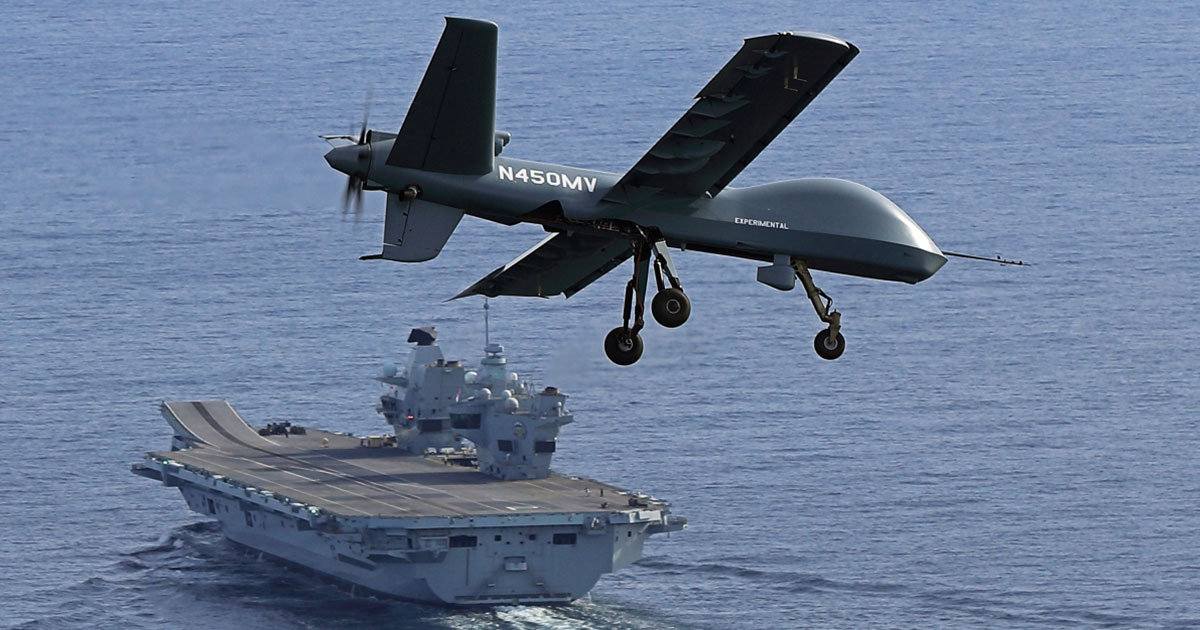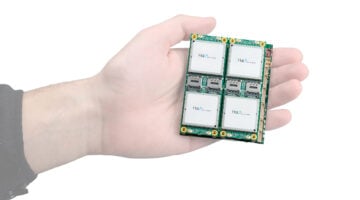
BELFAST — In collaboration with General Atomics Aeronautical Systems, Inc. (GA-ASI) the Royal Navy successfully launched and recovered a Mojave short take-off and landing (STOL) UAS on board HMS Prince of Wales — the UK’s largest aircraft carrier.
The flight test took place off the coast of Virginia, with the event marking the first time an uncrewed aircraft of Mojave’s size has ever flown off a carrier not belonging to the US Navy, the Royal Navy said in a statement Friday. The aircraft measures nine meters (29.5 feet) long and has a wingspan of 17 meters (55.8 feet).
A Mojave pilot manually directed line of sight flight of the aircraft using a carrier based ground control station.
“For the purpose of the test, direct line of sight was used, but in some future world operators would fly this just like a MQ-9 flies today, over satellite and remotely,” C. Mark Brinkley, chief marketing and communications strategist at GA-ASI, told Breaking Defense.
He said the test delivered a proof of concept for the Royal Navy based around operating large drones at sea.
Similarly, the Royal Navy stressed that the trial “unlocks the potential” of UK Queen Elizabeth-class aircraft carriers to operate with uncrewed air systems and F-35B fifth generation fighter jets.
The Mojave flight test was part of a four-month deployment by the warship to the eastern US seaboard, designed to expand operations with drones, fighter jets, helicopters and tiltrotors.
As Breaking Defense previously reported, General Atomics was issued a £1.25 million ($1.5 million) contract by the UK Ministry of Defence in May, with the stated objective of demonstrating a “threshold capability for a Short Take off and Landing Uncrewed Air Vehicle.”
Larger drones like Mojave, a modified version of the US Army’s MQ-1C Gray Eagle, are not yet operated by the Royal Navy. The service’s Fleet Air Arm currently relies on smaller systems like the AeroVironment Puma and Schiebel S-100 Camcopter rotary wing UAS (designated Peregrine by London).
General Atomics spent “approximately” six months testing a Mojave maritime flight deck concept to validate communications between the pilot and aircraft could be maintained while simulating an aircraft carrier moving at 15-20kts, according to Brinkley.
A team at the company’s Desert Horizon test facility in El Mirage, California, designed a custom built work station by fitting a ground control station, pilot seat and command and control software on to a flatbed truck.
During this round of testing, the truck drove to keep pace with Mojave as the aircraft reached low level flight.
“The demo portion of this was tricky for us because we weren’t flying over satellite and because this has never been attempted before,” said Brinkley.
He explained that “trying to make certain that you have all of the software” necessary to complete a manual Mojave landing, was one of the key elements the General Atomics team concentrated on during the six month test phase.
At a broader level, the Royal Navy flight test represents a significant step on the road to the manufacturer, demonstrating to navy operators the promise of a carrier-capable MQ-9B STOL concept, based on detaching the wings of the aircraft and fitting it with a STOL kit.
Such a concept can support carrier protection and surveillance missions at range, without the need for a catapult or arresting gear to recover the aircraft. The UK’s Royal Air Force has ordered 16 MQ-9B UAV’s (known as Protector), the first of which made its maiden flight from RAF Waddington, England, on Friday.
“We hope that the [Mojave] demo itself is going to be a catalyst for either a single nation that wants to operate UAS from Navy ships, or perhaps a conglomerate of nations that want to share the research and development to really flesh this out,” said Brinkley. “I would hate to put a dollar figure on that [type of future program] but we would be talking, most likely, about a MQ-9B STOL configuration.”

